
USnooBie Assembly Instructions and Parts Breakdown
Assemble the USnooBie according to these steps. The smaller components must be soldered first, before the larger components, this makes assembly easier. The parts required are also described here so this document also acts as a part list so you may find replacement components.

|
Two 68 ohm resistorsThese resistors limit the current between the USB device (microcontroller) and the USB host (computer) on the D+ and D- lines of the USB bus. They act as terminating resistors, so the terminating impedance matches the USB cable's characteristic impedance, reducing signal reflections. They are small and low components and are thus soldered first. These should be two 68 ohm 1/4 watt +/- 5% tolerance carbon film resistors. |

|

|
D- pull-up resistorThis resistor is placed on the D- line of the USB bus. When D- is pulled up, it indicates to the USB host that the USB device is a low speed USB 1.1 device. This resistor is usually 2.2 kilo-ohm if pulling up to 5V and 1.5 kilo-ohm when pulling up to 3.3V. 1.8 kilo-ohm works well with both 5V and 3.3V. This resistor should be one 1.8 kilo ohm 1/4 watt +/- 5% tolerance carbon film resistor. Note: the original design used a 1.7 kilo ohm resistor, the kit being sold is provided with a 1.8 kilo ohm resistor, either should work. The schematics may show a 1.7 kilo ohm resistor. |

|

|
LED current limit resistorThis resistor limits the current for the power indication LED. If this current is not limited, then the LED's lifespan is drastically reduced. This resistor may be omitted if the power indicator LED is omitted. If the power indicator LED is too bright, then replace this resistor with one that has a higher resistance. This resistor should be a 330 ohm 1/4 watt +/- 5% tolerance carbon film resistor. |

|

|
Two 3.6V Zener diodesThese 3.6V Zener diodes ensures that the signal on the D+ and D- lines of the USB bus are within acceptable limits. This allows the USB device to run at 5V without damaging other devices on the USB bus. Note that these diodes may be omitted if the USB device runs at 3.3V exclusively. However, the USnooBie is designed so that it can switch between using 5V and 3.3V, and these diodes do not interfere while the USnooBie is running at 3.3V. So it is recommended that these diodes are installed. These should be 1N5227B 3.6V Zener diodes. There have been reports that certain Zener diodes will not work. 200mW Zener diodes may not work but 500mW Zener diodes will (source: http://forums.obdev.at/viewtopic.php?f=8&t=4677). Ensure that you place these parts in the correct orientation as indicated by the symbol on the PCB. The triangle on the symbol points in the direction which the stripe on the diode should be. |

|

|
Reverse current protection diodeThis diode protects the USB host from any voltages over 5V, which can seriously damage the host. Imagine if your project is powered by a 9V battery, and you drop a screw onto your breadboard which connected the 9V positive terminal to your USB V+ line, this could damage your computer (I've done this with 6V and my computer shutdown instantly, and would not start until a few minutes later, very scary). This diode will prevent damage from this sort of event by only allowing the current to flow in one direction, so if the voltage on the USB device becomes higher than the voltage on the USB host, then no current will actually flow (since that current will be reverse). Due to the fact that diodes usually drop voltage significantly, it is recommended that this diode is omitted if the USnooBie will be used with 5V, as the voltage drop will make the available voltage too low for other 5V devices which you may plan on using. This diode is not included in the kit for this reason. If you must include this component, the MBRX0540 (0.5A but 0.5V drop) or similar may be used. If this part is omitted, then you must replace this part with a jumper wire or else the USnooBie will not receive power from the USB port.
This part is not included in the kit provided by Seeed Studio.
Ensure that you place this part in the correct orientation as indicated by the symbol on the PCB. The direction is indicated by the stripe on the diode and on the symbol. |
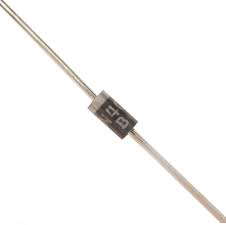
|

|
Power indicator LEDThis LED indicates that there is power on the power bus. Note that it does not indicate the amount of power, so even if it is lit, it does not guarantee that certain components are receiving enough voltage. This must be a 3mm diameter standard LED. This LED may be omitted if you want to save power or you want a "stealthy" USB device. Ensure that you place this part in the correct orientation as indicated by the symbol on the PCB. If you are unable to determine the direction of the LED, then you should test the LED before installing it. The "flat side" should be the cathode, which should be negative to light up, while the "round side" is the anode, which should be positive to light up. Use a 3V coin cell battery to perform this test really quickly to avoid damaging the LED. |
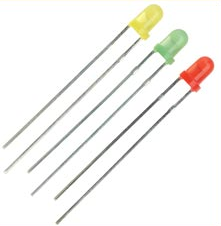
|

|
USB A male connectorThis allows the USnooBie to be plugged directly into a USB port, or you can buy a USB extension cable from the dollar store to connect it. |

|

|
Two tactile SPST momentary on push button switchOne button is used to reset the AVR microcontroller, the other button acts as a bootloader activation button. Upon reset, the AVR runs the bootloader section code which checks whether or not the bootloader activation button is held down. If it is held down, the bootloader becomes a USBasp device so you may load your own code into the AVR microcontroller. If it is not held down, then the bootloader jumps to the application section to run the code you have previously loaded. This bootloader activation button is placed on the D- line, when pressed during normal use (not during boot time), it will cause the USB device to appear disconnected from the USB host. This is useful in certain situations when you require your device to disconnect without physically disconnecting. The Omron B3F-1000 tactile SPST momentarty on push button switch should be used here. |
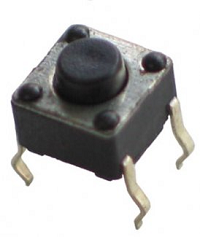
|

|
28 pin DIP chip socketA 28 pin DIP chip socket is used to hold the AVR ATmega microcontroller. Due to the placement of the three tandum capacitors, a 28 pin DIP chip socket must be used (or two 14 pin DIP chip sockets, the PCB layout is designed to allow this) to hold the AVR ATmega microcontroller. The chip socket should have a gap down its center, giving you room to place the three capacitors. Solder in the sockets first, then insert the capacitors through the gap. See the picture provided. Ensure that you place this part in the correct orientation as indicated by the symbol on the PCB. Do not insert the chip into the socket until the board passes some simple testing (later steps). |

|

|
Three monolithic capacitorsThe 0.1uF capacitor is a decoupling capacitor which smooths out fine ripples on the power bus. The code on this capacitor should be 104 (meaning 0.1uF). The two 27pF capacitors cleans the signals from the 12 MHz crystal. The code on these capacitor should be 270 (meaning 27 pF). These capacitors can be monolithic or ceramic. |
|

|
12 MHz crystalThe 12 MHz crystal is the clock source for the AVR microcontroller. It is 12 MHz because that's the best clock speed for 3.3V opertation that is supported by V-USB. You may substitute the 12 MHz crystal with another crystal that is supported by V-USB, however, if you are using 3.3V, there is a chance that your device will not work well with any speed higher than 12 MHz. The crystal must be a 12 MHz crystal in a HC49 package. Low profile packaging is prefered, as long as the pin spacing is the same. Note, the crystal is designed very close to four of the ATmega's chip socket solder pads. Although the board was designed with this in mind, the gap between the metal crystal casing and the solder pads for the chip socket are very close. You should perform continuity testing between the metal canister casing of the crystal and each of these four solder pads. If there is a problem caused by the metal canister casing contacting the pads, then simply unsolder the crystal and resolder it in place but with a slight gap between the PCB surface and the bottom of the crystal. |

|

|
Voltage selection jumperA three pin header is used to select the voltage on the power bus, a shunt block is used on the 3 pin header to make the connection that makes the selection. This allows you to choose between using the 5V power supply from the USB port or using the 3.3V power supply provided by the 3.3V voltage regulator. Do not install the jumper shunt block until the board has passed some tests (described in later steps). |

|

|
PTC resettable fuseThis fuse protects the USB host from damage during short circuit situations by cutting off current. The fuse will heat up when current reaches unacceptable levels and it will become a resistor, limiting the current drastically, and when the fuse cools down, it loses its resistance and conducts current again. This will protect your computer if you accidentally short your power bus. Since it resets itself automatically after cooling down, it will never need to be replaced (unlike an ordinary fuse). Note that the USB bus can only supply up to 500mA of current, the fuse provided will build up resistance once it reaches 250mA and cut off power completely if the current reaches 500mA. For most applications, this amount of power is enough, if you require more power, consider utilizing an external power source as the power supply, instead of your computer. Since this fuse is a safety feature, it may be omitted. If you choose to omit this fuse, replace it with a jumper wire, or else the USnooBie will not receive any power from the USB port.
This component should be the RXE025 from Tyco Electronics, it is the same PTC resettable fuse sold on SparkFun. It has a I-hold of 250mA and I-trip of 500mA. |
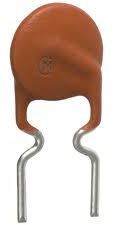
|

|
4.7 uF electrolytic capacitorThis capacitor smooths out large slow ripples on the power bus, and acts as a small reservoir during sudden current draw. This should be a 4.7 uF electrolytic capacitor rated at 10 volts in radial packaging. Ensure that you place this part in the correct orientation as indicated by the symbol on the PCB. The capacitor should have a strip on the side with negative (minus signs) symbols, which corresponds to the negative side of the capacitor symbol on the PCB (opposite to the pad with the positive + symbol). |

|

|
3.3V low dropout voltage regulatorThis is a low dropout voltage regulator that will step down the 5V USB power down to 3.3V. This may be omitted if you do not want a 3.3V power source. Ensure that you place this part in the correct orientation as indicated by the symbol on the PCB. The metal heatsink on the voltage regulator should face towards the inside of the board (as indicated by the thicker silkscreened line).
This component must be a 3.3V low dropout voltage regulator in 3 pin TO-220 packaging. Microchip's TC1262 or similar may be used.
|
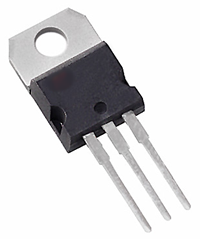
|

|
Male headersThere are three groups of male headers. One long group that has 16 pins, two shorter groups with 6 pins each. These male headers allow you to insert the USnooBie into a breadboard. These headers should go on the bottom of the PCB. To make soldering these header pins easier, you can try inserting them into the breadboard first, and then placing the USnooBie PCB on top, so that the breadboard keeps the header pins straight and holds them in place for you while you solder from the PCB's top side. |
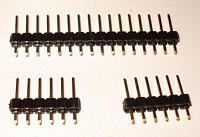
|

|
Continuity testing the groundUse a multimeter's continuity tester to check that all pins/pads/joints that are supposed to be ground are connected to each other and only each other. If this test passes, then you should be able to check the voltages while powered up without worrying too much about a short causing massive current draw. |
|

|
Continuity testing the power busUse a multimeter's continuity tester to check that all pins/pads/joints that are supposed to be on the power bus are connected to each other and only to each other. Do this while the voltage selection jumper shunt block is not installed. |
|

|
Voltage checkPlug in the USnooBie into a powered USB port and check the voltages on the pads/pins/joints which are supposed to be 5V. Do the same for the ones that are supposed to be 3.3V. Install the jumper shunt block on to the voltage selection jumper pin header. Check that you are able to select the voltage on the power bus by moving the jumper shunt block. When there is power on the power bus, the power indicator LED should also light up. |
|

|
Insert the microcontrollerInsert the AVR ATmega microcontroller into the 28 pin DIP chip socket to finish constructing the USnooBie. If the correct bootloader is already loaded on the microcontroller and the microcontroller's fuse bit settings are correct, you can start to use the USnooBie. Follow the instructions for loading code onto the USnooBie to check that it functions as a USB device when connected to a computer. A list of acceptable AVR ATmega microcontrollers (must be in 28 pin PDIP packaging):
|
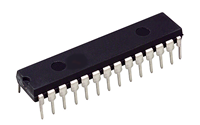
|